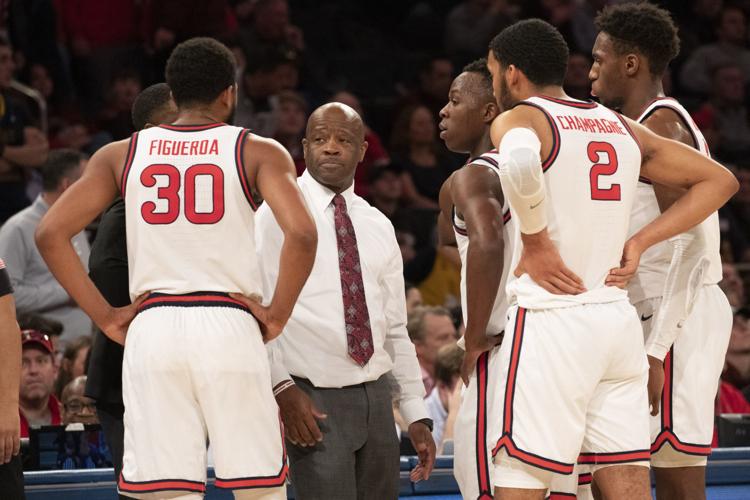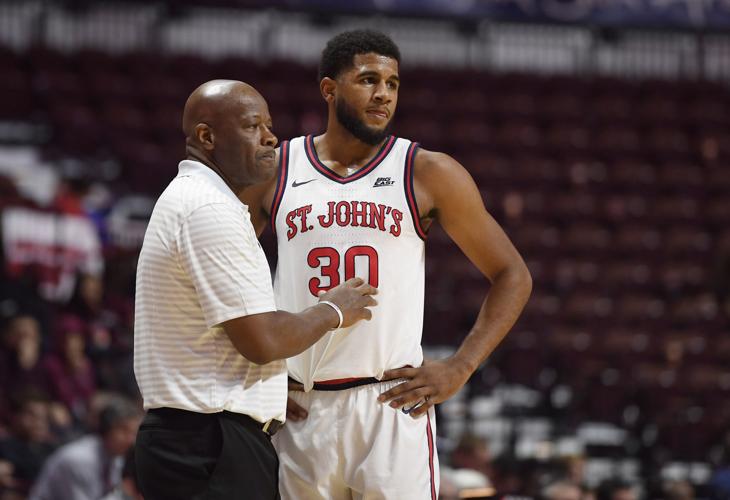With St. John’s basketball, the word “fit” may call for a closer look.
After all, this is a school that hired a homegrown Hall of Famer, Chris Mullin, to take over as head coach but never quite reached the heights it expected after four seasons, despite an NCAA First Four appearance last season.
Mullin resigned last spring, meaning he won’t be around Saturday when St. John’s takes on No. 16 Arizona at the new San Francisco home of the Golden State Warriors, for which he is also a legend.
Then there’s the new guy.
After Mullin left, St. John’s looked around, then found ASU’s Bobby Hurley, Iona’s Tim Cluess, UMBC’s Ryan Odom and even Loyola-Chicago’s Porter Moser weren’t interested.
Things became so bad that a prominent alum went on a widely heard New York sports talk show and proclaimed it a “national embarrassment.”
The Johnnies couldn’t find anybody who fit. So they hired one who did not appear to.
At least on the surface.
Mike Anderson was born and raised in Birmingham, Alabama. He played juco ball in Missouri, then for Nolan Richardson at Tulsa, and later became Richardson’s assistant coach for 17 years at Arkansas.
Head coaching opportunities followed at UAB, Missouri and Arkansas, where he was fired last March after eight seasons.
His coaching and playing radius did not reach anywhere near New York. But, in a way, his philosophy did.
Forty minutes of hell. That’s what Richardson’s teams were known for, the vintage Razorback teams that Anderson assisted with, and Anderson’s teams had heavy shades of it in their DNA, too.
Even with an 18-16 team last season, Anderson’s Razorbacks forced turnovers on 22.5% of their opponents’ possessions, the 16th best turnover rate in Division I, and they held the ball offensively for an average of only 15.9 seconds, the 29th shortest time in Division I.
His teams were known for playing fast. New York is known for living fast.
Maybe he was a fit in spirit, if not geography.
Anderson discovered that when he returned to Arkansas a month after he took the new job in Queens.
“The pace was unbelievable,” Anderson told ESPN before the season (he was unavailable for comment earlier this week). “I went back there and it was like things were in slow motion.”
It’s far too early, of course, to determine the long-term viability of Anderson’s hiring. The Red Storm has played the 11th-weakest schedule in the country, according to Kenpom, and their 10-2 record includes an 80-67 loss to ASU in Connecticut.
Their talent is still midlevel, led by transfers Mustapha Heron and LJ Figueroa, but their style is compelling.
According to Kenpom, St. John’s so far has the 19th fastest tempo, the fifth shortest possession length (just 14.5 seconds) and 15th best steal percentage (taking the ball away on 13% of opponents’ possessions.)
They press after opponents’ made baskets, free throws and dead balls, and they race downcourt offensively. Nine players average 15 minutes or more in order to sustain the energy that style of play tends to require.
“They play extremely hard, they’re very aggressive on defense, they have key guys that can get them points, and there’s more of a stable commitment defensively and also how they go to the offensive boards,” Hurley told the New York Post before the Sun Devils beat St. John’s on Nov. 23.
“There aren’t stretches where they are disconnected from what they are doing.
“There appears to be a good cohesiveness among the players that are out there. They are playing a lot of guys and the chemistry looks good.
“There’s a purpose to what they’re doing. They want to attack; they want to play quick; they’re going to make you uncomfortable and try to turn you over.”
Fans may not have yet bought in completely: St. John’s is averaging only 3,722 fans for 10 home games, counting a crowd of 7,281 against West Virginia at Madison Square Garden (the other nine games have been in Queens).
But the players appear to be enjoying the ride, so far at least.
“I like it because we can just get after it,” St. John’s guard Greg Williams said Wednesday, after the Red Storm beat Albany 85-57. “I feel like when we all come together and play hard like that it just makes everything fun.
“We’re going up and getting loose balls, getting steals and just communicating with each other without saying anything. We just trust each other and kind of feel for each other throughout the court.”
Like Williams, fellow sophomore Marcell Earlington averaged less than nine minutes last season under Mullin. But now he pretty much epitomizes the Red Storm’s frenetic approach: Despite averaging just 16.2 minutes a game, he averages 8.3 points, 5.0 rebounds and has the fourth most steals (11) on the team.
Not a second of time is wasted on the court.
“His style definitely fits me because I like to just be all over the place,” Earlington said of Anderson. “Just him giving me the opportunity to pick up the point, pick up multiple positions and be out there and be aggressive, I love it.
“He gives us that freedom to just go out there and play our game. It shows everybody’s having fun. It shows on the court.”





